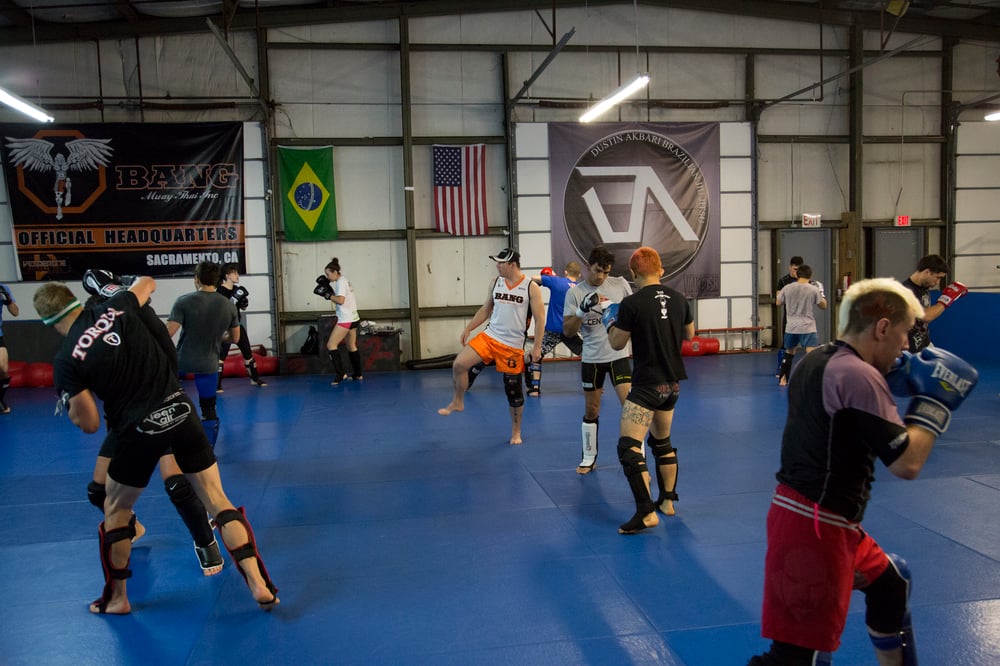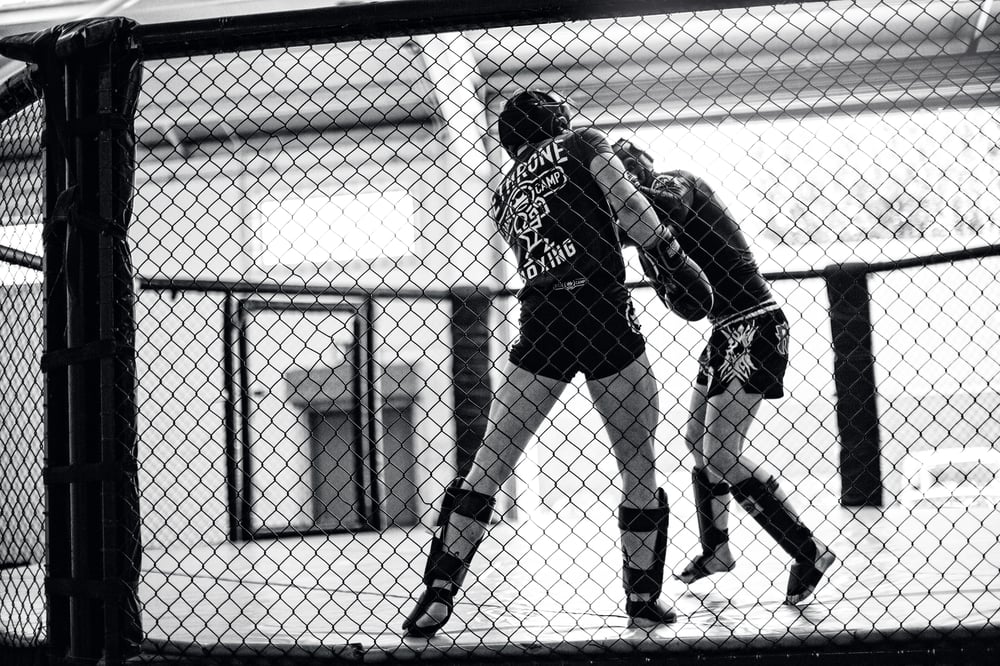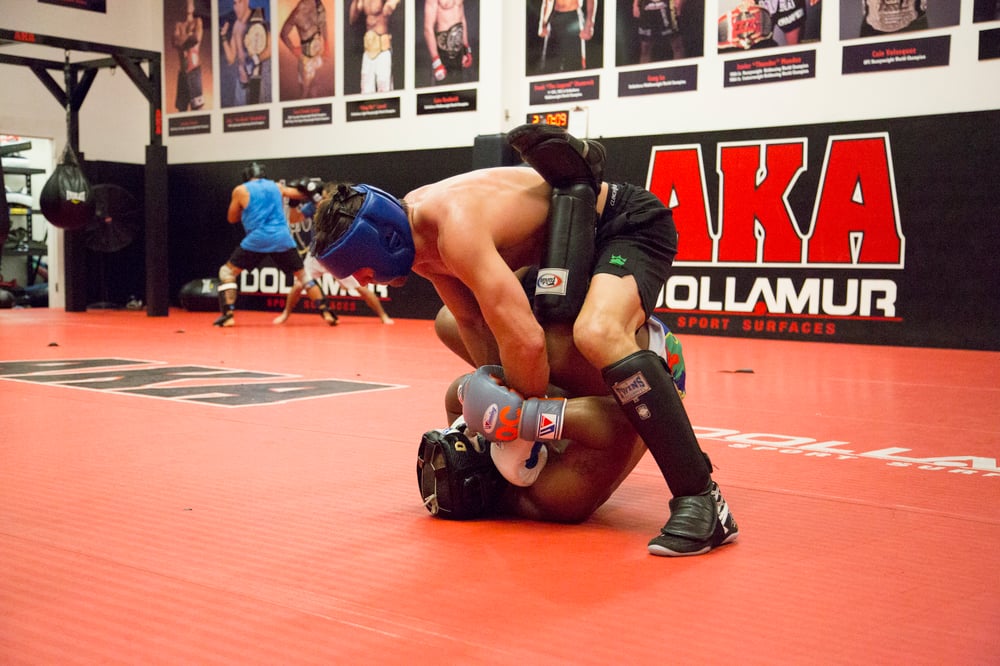
Issue 124
January 2015
Gloating about a sparring session is considered a huge faux pas in the fight game, so why are mixed martial artists becoming increasingly loose lipped? FO investigates.
Sparring stories are a fighter’s equivalent of a tabloid kiss-and-tell. They’re often scandalous, usually untrue, and more often than not tend to annoy one or both of the parties involved. They’re also very much a feature of the game. They have been for years.
Spiked by the sudden power of social media and society’s increasing need to hear and spread gossip, however, there appears to be a growing trend for mixed martial artists to go public with sparring stories. This has shattered the illusion that there’s some kind of omertà or code of silence in place once the gym doors close.
Only recently we saw middleweights Michael Bisping and Luke Rockhold use an old sparring session as a subplot to an upcoming fight. Both bickered about what actually happened before Rockhold settled matters decisively for real via a second-round submission in Australia in November.
Then we had Andre Arlovski and Anthony ‘Rumble’ Johnson commenting on the aggressive and dangerous sparring habits of Alistair Overeem – the man responsible for injuring Jon Jones and putting him out of a light heavyweight title defense against Daniel Cormier.
Most harsh of all, though, was Hector Lombard’s decision to use an appearance on the MMA Roasted podcast to claim he had once knocked out fellow welterweight Tarec Saffiedine in a sparring session.
“I don’t even pay attention to that guy,” Saffiedine told FO. “He’s talking about something that happened six years ago when I was 30lb lighter than him. I’d just had an hour-long training session and was tired. But he goes on Twitter and on the radio and says these things about it. Come on, that’s just stupid. It doesn’t make him look any good.
“I’ve beaten people up in training and would never tell anybody about it, especially not the media. I’m not that sort of guy. Also, if we were to fight one day, our sparring session wouldn’t mean I’d beat them up again for real. They’re two totally different things.
“Some people just like to boast and say, ‘Oh, I beat up that guy in training.’ It doesn’t mean anything. What counts is the day we fight. That’s all that matters. What happens in training is just what happens in training.”
That certainly should be the case, so say many of the top coaches in the game.
“It’s pretty much common sense that whatever happens in the gym should stay in the gym,” says Trevor Wittman, head trainer at Grudge Training Center. “If someone wants to talk about how good the sparring was, or what they did to some other guy, that shows a weakness. When you’re sparring in front of coaches and there’s no fans and no high energy, it’s 100% different to being underneath the lights on fight night.
“Anybody who leaves the gym thinking they’ve got the number of a guy they’ve just sparred is a fool. If someone came into my gym, sparred my guy and then left and said that stuff, I’d see that as a weakness on their side because we have not shown them our true self.”
“I don’t know whether it always does stay in the gym, but it definitely should,” adds Jeremy Horn, a former UFC fighter and veteran of a whopping 117 professional mixed martial arts bouts. “Training is where you work on things and take yourself out of your comfort zone. It’s where things don’t always run smoothly. You have your good days and bad days. It’s not really right for people to judge you on the good or bad and then air it in public.
“But there’s no actual rule in place. It’s up to the guys themselves to keep it between them. It’s always just been a kind of an etiquette thing.”

Duane ‘Bang’ Ludwig, former UFC welterweight and 2013 World MMA Awards ‘Coach of the Year’, doesn’t necessarily believe spreading rumors is the right thing to do, but he doesn’t see too much of a problem with it, either.
“I never pay too much attention to that,” he says. “It’s not something a lot of guys do, at least not in my experience. People can talk however they want. It just shows what kind of personality they have. If they remain quiet and respectful, that’s good, but you’ll always have some guys that can’t keep their mouth shut. I let people handle their own business.”
Sparring sessions are the fights fans never get to see. They’re sometimes vicious, revealing, controversial and tasty, but play out in gyms before an audience of only a few with no titles or bonus checks up for grabs.
Essentially practice, they still feature fighters and where fighters are involved there tends to be no small amount of competition. While some exhibit calmness and see sparring for what it is – a chance to work on areas of their game – others take a vastly different approach. They view it more in line with an actual fight and go a little harder.
This contrast often causes conflict. Those who go soft like to think they’re preventing wear and tear, whereas those that go hard believe they’re getting their body and mind hardened for the rigors of war ahead.
“A sparring session and a fight should be two very different things,” Ludwig says. “Sparring should be about holding back and working on things. We should think about growing and progression, not hurting each other. I want to make sure my fighter uses that session to get better. It’s not about seeing who is the toughest guy or who hits the hardest.
“I have my guys do a whole bunch of sparring drills which emulate the fight, but actual full-on, hard sparring at 100% rarely takes place. Too much of that kind of stuff can shorten a fighter’s career.”
Wittman agrees. “Sparring is not fighting. A lot of people think it’s just the bigger gloves and headguards that mean that, but it’s not. If you go to any high-level gym you’ll understand the scientific training behind sparring. It’s not the same as fighting unless you’re two or three weeks out from a fight. Then it gets a little closer. But it’s still nowhere near the same. It’s like scrimmages in football or taking corner kicks in soccer. It’s just practicing, drilling.”

A true original and one of the old-school, Horn has been involved in thousands of sparring sessions over the course of his 18-year fighting career. During that time he’s seen all sorts. He’s seen the tough guys and the technical guys.
“I’d spar usually two or three times a week,” he said. “A couple of times I’d do six or eight rounds and kind of light – just moving and learning the techniques – and then one day I’d go four or five rounds pretty hard.
“For the most part, though, a sparring session won’t simulate an actual fight all that often. You’re generally sparring with your training partners and friends, people you respect and people who respect you. You’re working together to improve. You’re training with people you are comfortable around so that that mental agitation isn’t always there.
“Personally, I’ve always favored a more technical approach to sparring. You don’t really need to go in there and get your bell rung every day to learn. I think you can learn from just moving and by having a healthy respect for what’s going on. You don’t need to get hit hard to learn. Most of the time you can learn a hell of a lot more from going a little bit lighter and realizing why certain things do and don’t happen for you in there.”
Ultimately, it’s all about getting the balance right. More and more mixed martial artists today seem to value the perks of the technical approach to sparring. It reduces injury and issues between fighters. Too much science can dilute and weaken the fighting spirit bubbling beneath the surface of any professional fighter though. Saffiedine, the former Strikeforce welterweight champion and current UFC contender, has become a master of both approaches.
“Some days I’ll do situation sparring where one guy might be on defense or on offense and I’ll be working on certain areas of my game,” he reveals. “It won’t be free sparring or hard sparring. We’re not going 100%.
“But I’m also a big believer in hard sparring. Some fighters don’t do any hard sparring. They don’t believe in it. They want to save it for the fight. I believe you can go hard though, just not every day. I try to go hard at least once a week. I’m not trying to knock anyone out during these spars, but you’ve got to go pretty hard to get that feeling of stress you get in fights. You need that adrenalin rush from time to time.
“A lot of boxers do that every time they spar and it works for them. In fact, a boxer’s sparring partner will sometimes be paid money to try and knock them out. They want that danger. They want to feel stressed.”
There’s a great deception to sparring. It’s the warm-up before the hustle. As such, some guys hold back and don’t show their full hand in anticipation of one day meeting their sparring partner for real in the future. They think it makes no sense to offer any kind of insight into their game. Far better to stay aloof and vague, a blank canvas.
“When I spar I actually try to do a lot of mistakes,” says Saffiedine. “I work on stuff I’m not very good at. I want to test my weaknesses and work on all the stuff I don’t want to be doing in a fight. I’ll put myself in bad situations to try and get out of them. When I grapple I always put myself in bad situations.”
This kind of attitude means fighters rarely produce their best work in the gym. Instead, you get a watered down version.
“Clay Guida is a fine example,” Wittman says. “He’s one of those guys you look at in the gym and think, ‘Oh my God, this guy looks like he’s just starting out.’ But the only thing he does in the gym that he also does on fight night is jog around the cage when he’s getting ready. He’s always full of energy. Other than that, though, he’s completely different in sparring. He’s beatable. People have their way with him. You think, ‘How can this guy fight in the UFC?’ The thing is, he just loves to compete so much, and is a gamer, so when fight night arrives he rises to the occasion. Not all fighters are able to do that. He’s in his element on fight night.”

Guida is an exception. Far more common is a fighter who looks invincible in sparring but then freezes up on fight night. They struggle under the lights and the pressure.
Ludwig says: “On fight night a fighter will tend to focus on things that are outside their control. This doesn’t happen so much in the gym. They’re more relaxed, there’s less at stake. I don’t know what people are focusing on when they spar, but they’re not worrying about getting beaten or having an ‘L’ on their record.”
Horn agrees: “When you’re sparring someone, you know that your opposite number should be helping you out. If he hurts you, he’s not going to try and finish you. But, in a fight, you know you only have once chance. If you make a mistake, it could be your last mistake and you could lose the fight. So, of course, you’re second guessing everything and you’re more anxious and apprehensive in a fight.
“That’s why I believe it’s important to train and spar with the mind-set that it’s a fight. You don’t need to go super hard, but you need to be focused and switched on. Don’t jack around. It’s one thing to experiment with new toys and take the odd risk, but you see a lot of guys who jack around in sparring and try a lot of crap they don’t do in a fight. If that’s not the sort of stuff you do during a fight, why are you wasting your time doing it in sparring?”
Many instances of dementia pugilistica in boxers have been attributed to not only fights – those on the boxer’s record – but also the countless rounds of intense, competitive sparring they racked up behind closed doors. It’s all punishment, whether it’s labelled ‘practice’ or not. Practicing some things can be enjoyable. Getting repeatedly hit isn’t.
“I wouldn’t say guys get knocked out in sparring very often,” says Wittman. “That happens once in a while, but not regularly. I’m a big believer in the idea that once that happens – a guy gets hurt or knocked out – you are on suspension. Depending on the severity of the knockout, and how they behave afterwards, I’ll suspend them from sparring.
“Duane Ludwig fought Amir Sadollah with no sparring throughout the whole training camp. All we did was work on mitts and timing. He then looked spectacular on the night. But there are other times when we do camps with plenty of sparring and our guy goes in there and doesn’t perform.
“In the beginning I think hard sparring is great because it toughens the fighter up and gives them their real conditioning. But, once you’ve fought for many years, I believe tech sparring is more beneficial. Robbie Lawler says the same. These guys feel sharper and they’re not leaving with the cloudiness and the headaches after hard sparring. Some guys you should pull back and say, ‘Let’s just do tech sparring for this camp.’”
Ludwig has his say: “Sparring was awesome for me. It was a lot more like fighting than what I do with my guys now. It was something I really enjoyed. I had a few injuries towards the end of my career, though, which meant I had to hold back on sparring and not do so much.
“Holding back on sparring helped me reduce that wear and tear and prolong my career a little longer. In fact, I didn’t do any sparring at all for the last few fights of my career.”
Shhhhh. Don’t tell anyone. Remember, what happens in the gym stays in the gym.
SPARRING SMACK TALK
CHUCK LIDDELL VS. TITO ORTIZ
One of MMA’s most famous feuds ignited when Ortiz refused to fight Liddell. ‘The Huntington Beach Bad Boy’ said it was because their friendship meant they should be paid more, but ‘The Iceman’ and UFC president Dana White thought otherwise. It was because of the pair’s sparring history.
“Chuck was in Tito’s head because every time they would train together, that was it,” said White. “ Tito got beat up. Chuck would drop him and Tito would refuse to get up. He knew he would lose.”
According to Liddell, Tito ended up refusing to even practice with him: “He’d have some reason why he didn’t make the sparring. He was afraid of me.”

DANIEL CORMIER VS. PAT CUMMINS
Pat Cummins proved it was a bad idea to bring up the past in the run up to his fight with Daniel Cormier in February. ‘Durkin’ was called in as a late replacement just days before UFC 170 and immediately went to work to hype the contest by opening up some old wounds. He claimed to have broken ‘DC’ and made him cry during wrestling practice for the 2004 Olympic games.
“I know I will push him and he will break. It’s that simple,” Cummins said.
This set Cormier off. Accusations of tears on the mat may have been true, but the 205lb standout was trying to cope with the tragic death of his daughter throughout that training camp. Cummins had crossed a line.
“Things that happened in that wrestling room stay in that wrestling room,” said Cormier. “Not only have you crossed the line, you’ve completely put yourself in my cross hairs. You’re going to suffer for your words... I want you to get beat up for a good bit of time.”
Though not drawn out, Cummins’ punishment was emphatic. He lasted just 1:19 of the first round as his opponent delivered a barrage of punishing punches for a decisive TKO. Even in victory, Cormier maintained his disdain for his former training partner.
“It had to happen this way. He couldn’t have gone the distance,” he said. “I’m mad that he even hit me twice because of what he did. When you talk you’ve got to be able to back it up. That’s what I do.”










